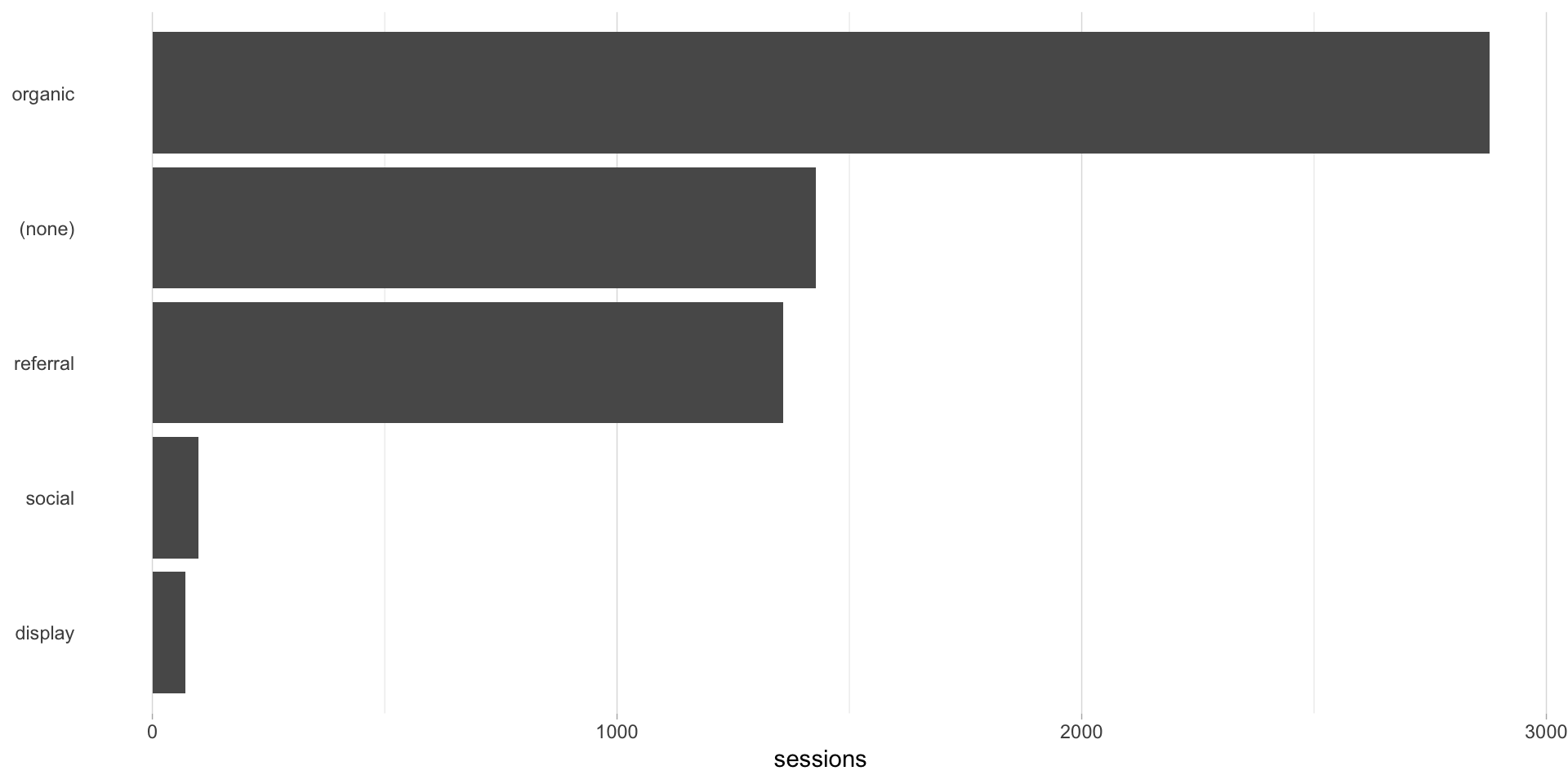Medium Ordered by Sessions
This example pulls the top 5 mediums by sessions for the last 30 days ordered in descending order by sessions.
Setup/Config
Be sure you’ve completed the steps on the Initial Setup page before running this code.
For the setup, we’re going to load a few libraries, load our specific Google Analytics credentials, and then authorize with Google.
# Load the necessary libraries. These libraries aren't all necessarily required for every
# example, but, for simplicity's sake, we're going ahead and including them in every example.
# The "typical" way to load these is simply with "library([package name])." But, the handy
# thing about using the approach below -- which uses the pacman package -- is that it will
# check that each package exists and actually install any that are missing before loading
# the package.
if (!require("pacman")) install.packages("pacman")
pacman::p_load(googleAnalyticsR, # How we actually get the Google Analytics data
tidyverse, # Includes dplyr, ggplot2, and others; very key!
devtools, # Generally handy
googleVis, # Useful for some of the visualizations
scales) # Useful for some number formatting in the visualizations
# Authorize GA. Depending on if you've done this already and a .ga-httr-oauth file has
# been saved or not, this may pop you over to a browser to authenticate.
ga_auth(token = ".ga-httr-oauth")
# Set the view ID and the date range. If you want to, you can swap out the Sys.getenv()
# call and just replace that with a hardcoded value for the view ID. And, the start
# and end date are currently set to choose the last 30 days, but those can be
# hardcoded as well.
view_id <- Sys.getenv("GA_VIEW_ID")
start_date <- Sys.Date() - 31 # 30 days back from yesterday
end_date <- Sys.Date() - 1 # YesterdayIf that all runs with just some messages but no errors, then you’re set for the next chunk of code: pulling the data.
Pull the Data
We just have to create an order_type object and then include that in the query.
# Create an order type object.
order_sessions_desc <- order_type("sessions",
sort_order = "DESCENDING",
orderType = "VALUE")
# Pull the data. See ?google_analytics_4() for additional parameters. Note that we are
# NOT using anti_sample = TRUE. This is because we are setting max = 5, and the max
# argument has no impact when anti_sample = TRUE.
ga_data <- google_analytics(viewId = view_id,
date_range = c(start_date, end_date),
metrics = "sessions",
dimensions = "medium",
order = order_sessions_desc,
max = 5)
# Go ahead and do a quick inspection of the data that was returned. This isn't required,
# but it's a good check along the way.
head(ga_data)| medium | sessions |
|---|---|
| organic | 2877 |
| (none) | 1427 |
| referral | 1357 |
| social | 99 |
| display | 71 |
Data Munging
Even though the data frame is ordered as we want it displayed, we still need to convert medium to a factor (with the levels in a reversed order) in order for the bar chart to be ordered from largest to smallest.
# Convert the medium to a factor so they will be ordered when plotted
ga_data$medium <- factor(ga_data$medium,
levels = rev(ga_data$medium))Data Visualization
This won’t be the prettiest bar chart, but let’s make a horizontal bar chart with the data. Remember, in ggplot2, a horizontal bar chart is just a normal bar chart with coord_flip().
# Create the plot. Note the stat="identity"" (because the data is already aggregated) and
# the coord_flip(). And, I just can't stand it... added on the additional theme stuff to
# clean up the plot a bit more.
gg <- ggplot(ga_data, mapping = aes(x = medium, y = sessions)) +
geom_bar(stat = "identity") +
coord_flip() +
theme_light() +
theme(panel.grid.major.y = element_blank(),
panel.grid.minor.y = element_blank(),
panel.border = element_blank(),
axis.title.y = element_blank(),
axis.ticks.y = element_blank())
# Output the plot. You *could* just remove the "gg <-" in the code above, but it's
# generally a best practice to create a plot object and then output it, rather than
# outputting it on the fly.
gg
This site is a sub-site to dartistics.com